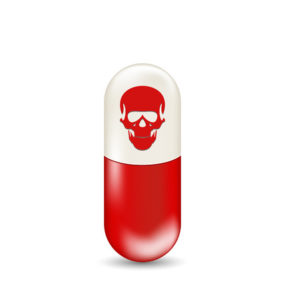Risky Alcoholism Treatment

The patent on Pfizer’s blockbuster drug, Lyrica (pregabalin) is running out; it is due to expire in December of 2018. More than six generics companies have lined up tentative approval to sell copies, according to Fierce Pharma. In an apparent effort to keep its blockbuster sales up despite the coming generics, Pfizer rolled out a longer-acting formula in 2017—Lyrica CR. In 2016 Lyrica generated $3.13 billion in sales in the U.S., a 26% increase over the year before. And despite the recent FDA concern that gabapentinoids like pregabalin having a potential for abuse, Pfizer is pushing ahead with a clinical trial to get pregabalin approved for treating alcohol dependence. The Phase 4 clinical trial by Pfizer, “Pregabalin for Alcohol Dependence,” should be completed just as Lyrica’s patent expires in December of 2018.
Gabapentinoids like pregabalin and gabapentin (Neurontin) produce euphoria at high doses. Their effects are similar to alcohol and benzodiazepines. And there is a clear abuse potential. Tolerance develops rapidly with repeated use and withdrawal symptoms have been reported. The U.K. is in the process of reclassifying gabapentin and pregabalin as Class C controlled substances because of evidence they can be abused.
An article on the British website for The Independent newspaper said the British Medical Association has called for pregabalin to be made a controlled substance in the same class as Valium, GHB and steroids. Yasir Abbasi, a consulting psychiatrist said pregbalin dependency was “very widespread, all over the UK.” He added it has an effect similar to Valium. “It sedates you and takes the edge off.” It has become a “massive” problem in prisons, where it is a very tradeable and desirable commodity. “When it goes off patent, and there are cheaper versions available, people will start buying it more and more, particularly over the internet.”
BuzzFeed described how Lyrica (pregabalin) is overprescribed and misused in a Greek refugee camp (Vial) in order to treat rampant depression, anxiety and PTSD. Although psychotherapy is supposed to be done concurrently with the medication, it’s impossible to do so under the circumstances. There are only one psychiatrist and one psychologist working at the camp. The UN refugee agency running the camp denied any knowledge of a Lyrica problem. However, others said the going rate on the camp’s black market for a 300mg Lyrica pill is $5.
A Syrian woman who has lived in Vial for months said: “The people here are desperate, they are suffering, and that [Lyrica] is something that makes them feel comfortable and happy. So they can stay here. They must take this medicine, so they can be patient here.” A former psychology student from Syria who was in the Vial camp was quoted as saying:
“Some people get the pill from the doctor, some from anybody here,” said T., a former psychology student from Syria who arrived in Vial in the spring of 2017. But the wait for an appointment with the doctor can be long. “Life here is hard. Some people take the pill. One, then two, three, four.” T. continued to count on his fingers, all the way up to 10 — “This is bad.” He said the medicine helped them relax and switch off for a bit. “They do not take them as medicine,” he said. “They take it like drugs.”
Along with baclofen, pregabalin and gabapentin (Neurontin) are analogues of the neurotransmitter gamma-aminobutyric acid (GABA). Many GABA analogues are used as anticonvulsants, sedatives and anti-anxiety drugs. According to Carleton Erickson in The Science of Addiction, alcohol affects GABA and a few other receptors to produce its intoxicating and behavioral effects. The GABA association between alcohol and these GABA analogues is simultaneously what attracts researchers to investigate their potential use as treatments for alcohol use disorder and what underlies their adverse effects.
In February of 2018, FDA Commissioner Scott Gottlieb commented on the FDA’s ongoing investigation into the misuse and abuse of gabapentinoids such as gabapentin (Neurontin) and pregabalin (Lyrica). “We’re concerned that the misuse and abuse of these drugs may result in serious adverse events such as respiratory depression and death. We want to understand changes in how patients are using these medicines.” Among the actions taken by the FDA is to review websites where opioid users exchange methods for misusing or abusing gabapentinoids. While this abuse does not yet appear to be widespread, the FDA hopes to stay ahead of any potential problem and is willing to take forceful action, if necessary.
Evidence for pregabalin abuse dates back to at least July of 2010, when a case report by Grosshans et al. was published in The American Journal of Psychiatry, “Pregabalin Abuse, Dependence, and Withdrawal.” At the time of the person’s admission, he was consuming 7,500 mg of pregabalin per day; 600 mg is the maximum recommended dose. He had a history of alcohol and cannabis abuse, but had been abstinent from heroin for seven years. Two years before his admission, he began using high doses of pregabalin and it quickly became habit. He developed tolerance and withdrawal symptoms. They did a gradual taper of pregabalin over 12 days, but he complained of a heavy craving for pregabalin and discontinued treatment. He relapsed immediately upon returning home. “Further attempts to motivate him for detoxification” failed and he continued to take pregabalin.
A case report of pregabalin dependence appeared in the Turkish Journal of Psychiatry. A 34 year-old man reported frequently using 7,800 mg of pregabalin daily. The most he’d used at one time was 15,600 mg. In the three years prior to his admission, his longest period of abstinence was three days. “When he tried to stop using pregabalin he experienced pessimism, aggression, anxiety, suicidal ideation, fatigue, excessive sleep, loss of appetite, palpitations, tremors, and vomiting.” Pregabalin use negatively effected his work and his family relationships.
Despite the promising reports on pregabalin use for treating substance dependence, 198 adverse events related to substance abuse and dependence, of which 16 were associated with pregabalin, occurred between 1980 and 2009 according to the Swedish National Register of Adverse Drug Reactions (SWEDIS).
Another case study report in the Indian Journal of Psychiatry by Ashwini et al. reported on yet another case study of pregabalin dependence and an attempted suicide. He was initially prescribed pregablin for neuropathic jaw pain and experienced euphoria and increased energy after taking his medication. After three years of continuous use, he was using 3,000 mg of pregabalin per day and would experience withdrawal if he missed his doses. He attempted suicide twice.” Our case highlights the abuse potential of pregabalin and risk of self-harm behavior with its continuous use.” The researchers recommended all clinicians remain vigilant and mindful of the potential for abuse or dependence, even if their patients are not showing any drug seeking behavior.
Case reports are not the only evidence of concerns with gabapentinoids. JAMA published a study by Patorno et al. looking at the increased risk of suicidality (attempts and completions) and violent death with a range of anticonvulsant drugs, including gabapentin and pregabalin. “Gabapentin treatment was significantly associated with higher risk of suicidal events and combined suicidal acts or violent deaths in adults and young adults.” Similar findings were not seen with pregabalin. However, it had only been on the market since 2005 (only patients who began taking an anticonvulsant between July 2001 and December 2006 were included in the study). It wasn’t as widely used at the time of the study as gabapentin and it had one of the shortest reported therapy times. The median time of use for all the anticonvulsants in the study was 60 days. Pregabalin would likely be used for a much longer time period in alcohol misuse treatment.
In “Misuse and Abuse of Pregabalin and Gabapentin: Cause for Concern?” Fabrizio Schifano wrote how gabapentinoids have been increasingly reported as having a potential for misuse and a relation to fatalities and a growing black market reported from “a range of countries.” He advised physicians thinking of prescribing gabapentinoids to carefully evaluate whether a previous history of drug abuse exists. Pregabalin has a higher potency (six times that of gabapentin), quicker absorption rates (within one hour) and greater bioavailability than gabapentin. Schifano suggested that while one could conclude the distinct pharmacokinetic advantages of pregabalin would mean an improved therapeutic effect, “[it] may explain as well why pregabalin is anecdotally perceived as more ‘powerful’ by drug misusers.”
Schifano did note that pregabalin, if used at therapeutic levels, “may present with beneficial effects” for alcohol misuse treatment. Similarly, he pointed to how gabapentin has been indicated in the treatment of drug addictions. Nevertheless, “A better assessment/clarification of gabapentinoid misuse potential levels is indeed of interest.”
The epidemiology of gabapentinoid misuse needs further detailed and urgent assessment, and consideration of gabapentin/pregabalin testing in urine drug screens should be routinely considered. Further empirical studies with gabapentinoids should be encouraged, focusing on a better assessment of their addictive liability levels across a range of dosages and in individuals with a previous substance misuse history.
Gabapentin has already become a drug of abuse in its own right. See “Foolishness with Gabapentin” and “The Evolution of Neurontin Abuse.” It’s often used to potentiate the euphoric effects of opioid drugs—both legal and illegal ones. The authors of “Abuse and Misuse of Pregabalin and Gabapentin” said: “Evidence suggests gabapentinoids possess potential for abuse, particularly in individuals with a history of opioid abuse, and reports of such abuse are increasingly being documented.” Over four years ago I expressed concern with using gabapentin to treat alcohol dependence in “The Dark Side of a Pill to Cure Addiction.” The same concern exists today with pregabalin: “well meaning researchers and clinicians could be putting the very people they seek to help at risk with the solutions they propose.”


